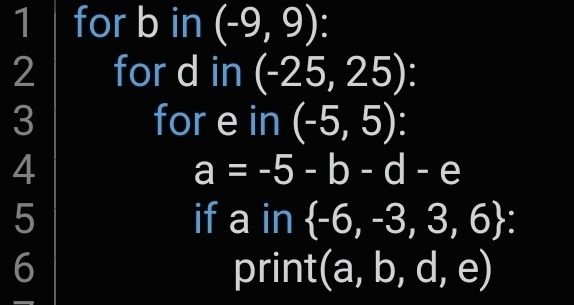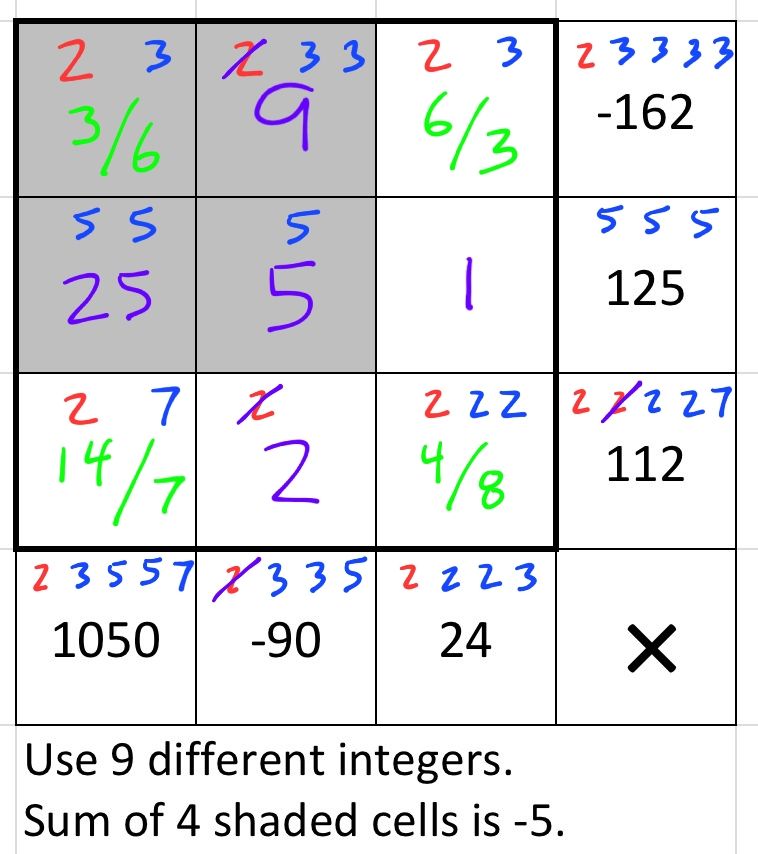Smacked a time or two with the autism stick, don't get offended if I insist on calling your foot-powered digging implement a spade.
This gives only one solution,
a = 6
b = 9
c = -3
d = -25
e = 5
f = -1
g = -7
h = -2
i = 8 ✅

This gives only one solution,
a = 6
b = 9
c = -3
d = -25
e = 5
f = -1
g = -7
h = -2
i = 8 ✅
1/

1/


so 2^d != 1
so d > 0
so d = 1 and c = 0
then f > 1
so f = 2 and e = 0
then a > 2
so a = 3 and b = 0
which gives us a single solution,

so 2^d != 1
so d > 0
so d = 1 and c = 0
then f > 1
so f = 2 and e = 0
then a > 2
so a = 3 and b = 0
which gives us a single solution,
Now we have a constraints problem where
a..f in Z >= 0
a + b = 3
c + d = 1
e + f = 2
a + c + e = 3
b + d + f = 3
1/


Now we have a constraints problem where
a..f in Z >= 0
a + b = 3
c + d = 1
e + f = 2
a + c + e = 3
b + d + f = 3
1/




column 30 must contain 1 and 9 as its square values
column 475 must contain 25 and 225 as its square values and 75 and 150 as its non-squares
row 130 must contain 9
row 258 must contain 225
That gets us to

column 30 must contain 1 and 9 as its square values
column 475 must contain 25 and 225 as its square values and 75 and 150 as its non-squares
row 130 must contain 9
row 258 must contain 225
That gets us to








The second combination is not possible, because there are no values which can intersect with row 28 (56 and 80 are both too large).
So column 178 must be {1, 35} in the grey cells, 2 in the bottom cell, 140 in the top cell.

The second combination is not possible, because there are no values which can intersect with row 28 (56 and 80 are both too large).
So column 178 must be {1, 35} in the grey cells, 2 in the bottom cell, 140 in the top cell.
The only constraints so far are
1. combinations of 4 unique factors of 560
2. sum to required values
3. grey cells are odd
1/


The only constraints so far are
1. combinations of 4 unique factors of 560
2. sum to required values
3. grey cells are odd
1/




I will represent the board as an 8×7 grid where each cell is a boolean "occupied" flag.
That gives a total of 56 bits, so can map to a single uint64 value.
Using an extra column along the right edge lets me pre-mark it as already-occupied,
1/

I will represent the board as an 8×7 grid where each cell is a boolean "occupied" flag.
That gives a total of 56 bits, so can map to a single uint64 value.
Using an extra column along the right edge lets me pre-mark it as already-occupied,
1/
9 (780 - v) + 10v = 15 • 480
7020 + v = 7200
v = 180
(1 - 2/3) 180 = 60 👈
Erika had $600 and spent $360
Veronica had $180 and spent $120
Veronica has $60 remaining. 👍

9 (780 - v) + 10v = 15 • 480
7020 + v = 7200
v = 180
(1 - 2/3) 180 = 60 👈
Erika had $600 and spent $360
Veronica had $180 and spent $120
Veronica has $60 remaining. 👍
where g in Z | 0 <= g <= 130
then 130 - g is the number of boys
(130 - g)/3 + 3g/7 = 50
7(130 - g) + 9g = 21 • 50
910 + 2g = 1050
g = (1050 - 910)/2 = 70
3/7 (70) = 30 👈
So 30 girls (out of 70) prefer fiction. 👍

where g in Z | 0 <= g <= 130
then 130 - g is the number of boys
(130 - g)/3 + 3g/7 = 50
7(130 - g) + 9g = 21 • 50
910 + 2g = 1050
g = (1050 - 910)/2 = 70
3/7 (70) = 30 👈
So 30 girls (out of 70) prefer fiction. 👍




